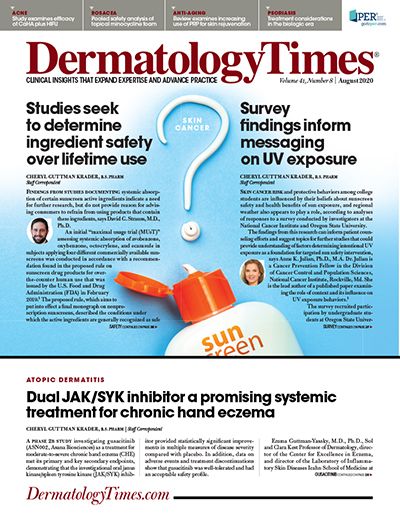- Case-Based Roundtable
- General Dermatology
- Eczema
- Chronic Hand Eczema
- Alopecia
- Aesthetics
- Vitiligo
- COVID-19
- Actinic Keratosis
- Precision Medicine and Biologics
- Rare Disease
- Wound Care
- Rosacea
- Psoriasis
- Psoriatic Arthritis
- Atopic Dermatitis
- Melasma
- NP and PA
- Skin Cancer
- Hidradenitis Suppurativa
- Drug Watch
- Pigmentary Disorders
- Acne
- Pediatric Dermatology
- Practice Management
- Prurigo Nodularis
- Buy-and-Bill
Publication
Article
Dermatology Times
PRP increasing in popularity for periorbital rejuvenation
Author(s):
Autologous platelet-rich plasma therapy is gaining in popularity and finding its niche alone and in combination with other skin rejuvenation procedures.
Autologous platelet-rich plasma (PRP) therapy is being used more frequently and could play a promising role as a monotherapy or in multimodality regimens for periorbital rejuvenation, according to authors of a recent review.1
Mohamad Goldust, M.D., department of dermatology, University of Rome G. Marconi, Rome, Italy, and fellow researchers recently conducted a collaborative literature review to evaluate commonly used non-surgical and minimally invasive treatment modalities for periorbital rejuvenation. They performed a search of published clinical trials and scientific reviews concerning periorbital rejuvenation in the MEDLINE and PubMed electronic databases.
The periorbital region of the face is central to the creation of the perception of age among all races and age groups, the authors note. Typical cosmetic concerns include periorbital wrinkles, melanosis and more prominent tear troughs.
Treatment options include chemical peeling, mechanical and laser resurfacing techniques, PRP, neuromodulation, soft tissue fillers, as well as energy-based modalities. Each of these treatment modalities can be effective for periorbital rejuvenation; however, they each have limitations, they authors cite. Clinicians must be able to skillfully navigate among them to best address their patients’ concerns.
Topical agents that can address periorbital pigmentation include tretinoin creams, hydroquinone, kojic acid, azelaic acid, vitamin C, caffeine and peptides.
“Hydroquinone is one of the most commonly used agents for pigmentation reduction in strengths varying from 2% to 6%,” the authors wrote. “In a study performed in Indian patients, 4% hydroquinone was found to be effective and tolerable to treat periorbital hyperpigmentation.”
Chemical peeling has been used for both periorbital pigmentation and wrinkles. The segmental chemical peels with phenol-croton oil is cost-effective, the authors write, and has been associated with lasting neocollagenesis.
While forms of dermabrasion have been used, it still carries scarring risk and has been largely replaced by safer therapies like fractional lasers, the authors say.
Non-ablative lasers like intense pulsed light, pulse dye, ND:YAG 1320nm, Nd:YAG 1064 nm and Erbium glass 1540 are safer treatment options for periorbital rejuvenation, the authors write. These devices have been associated with improvement in eyelid tightening, improved skin flexibility and wrinkles, increases in collagen and reduced melanin with no major side effects, according to studies the authors cite.
Neruomodulators and soft tissue fillers alone and in combination with other modalities have been useful for reducing wrinkles and filling in the tear trough region; however, use of fillers in this area has been associated with complications. Clinicians should have strong knowledge of anatomy and injection technique.
The researchers found that autologous PRP therapy is increasingly being used in dermatology for skin and hair conditions, and its use is quickly growing in popularity as a modality to achieve skin rejuvenation. The study results also confirm the mechanism by which PRP leads to skin rejuvenation, namely by increasing the dermal fibroblast proliferation, as well as the expression of matrix metalloproteinase and collagen synthesis.
“The mechanism by which PRP leads to skin rejuvenation is by increasing the dermal fibroblast proliferation, expression of matrix metalloproteinase, and collagen synthesis,” the authors write. “The ideal platelet concentration is 2-4 times over baseline, and with a concentration in this range, the highest secretion of endogenous hyaluronic acid was described for skin fibroblasts. These actions can have a positive effect on skin quality and may contribute to a decrease in visible signs of skin aging.”
While PRP has demonstrated efficacy in periorbital rejuvenation, more studies are needed to assess the longevity of cosmetic effects. According to the study authors, PRP has a rejuvenating capacity and can be considered in combination with other procedures including fractional lasers and fat grafting. Data has shown that PRP decreases healing time and enhances the healing overall when combined with other resurfacing modalities.
Periorbital aging may be a cosmetic issue, but it can cause psychological distress, the authors say.
“The evidence discussed in this article indicates the increasing importance of minimally invasive modalities in periorbital rejuvenation and a promising role for PRP as solo therapy or in multimodality regimens,” the authors write.
Disclosure:
The authors reported no relevant disclosures.
Reference:
1 Kassir M, Kroumpouzos G, Puja P, et al. Update in minimally invasive periorbital rejuvenation with a focus on platelet-rich plasma: A narrative review. J Cosmet Dermatol. 2020;19(5):1057-1062.






